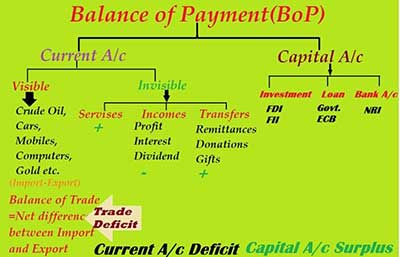Relevance: GS-3: Indian Economy, growth and development./ GS-2: Important International Institutions and its instrument.
Key phrases: SDR, IMF, BOP, Foreign Reserve asset, currency, asset, SDR allocation
Why in News?
- Of the accretion of $31.2 billion in July-September 2021 in foreign exchange reserves, $17.86 billion was by way of Special Drawing Rights (SDR) support received from the International Monetary Fund (IMF) on 23 August 2021.
What is the SDR?
- The SDR is an international reserve asset, created by the IMF in 1969 to supplement its member countries’ official reserves. To date, a total of SDR 660.7 billion (equivalent to about US$943 billion) have been allocated. This includes the largest-ever allocation of about SDR 456 billion approved on August 2, 2021 (effective on August 23, 2021).
- The SDR is neither a currency nor a claim on the IMF. The SDR was initially defined as equivalent to 0.888671 grams of fine gold—which, at the time, was also equivalent to one U.S. dollar. After the collapse of the Bretton Woods system Bretton (It required a currency peg to the U.S. dollar which was in turn pegged to the price of gold. The Bretton Woods System collapsed in the 1970s but created a lasting influence on international currency exchange and trade through its development of the IMF and World Bank), the SDR was redefined as a basket of currencies.
- The value of the SDR is calculated from a weighted basket of major currencies, including the U.S. dollar, the euro, Japanese yen, Chinese yuan, and the British pound.
- The SDR basket is reviewed every five years, or earlier if warranted, to ensure that the basket reflects the relative importance of currencies in the world’s trading and financial systems
- The SDR interest rate (SDRi) provides the basis for calculating the interest rate charged to member countries when they borrow from the IMF and paid to members for their remunerated creditor positions in the IMF.
- SDRs are allocated based on the quota amounts of each member country. The higher the quota amount, the larger the SDR allocation a country will receive. In general, stronger economies have higher quotas.

How do SDRs help maintain balance of payments?
- SDRs, created by the IMF as meant to supplement countries’ reserves.
- Adding SDRs to the country’s international reserves makes it more financially resilient.
- Providing liquidity support to developing and low-income countries allows them to tide over the balance of payments (BOP) situations like the one India has been experiencing due to the pandemic and the one it faced earlier in 1991.
- SDRs being one of the components of foreign exchange reserves (FER) of a country, an increase in its holdings is reflected in the BOP.
Balance of payments (BOP)
- The BOP, also known as the balance of international payments, is a statement of all transactions made between entities in one country and the rest of the world over a defined period, such as a quarter or a year.
- It summarizes all transactions that a country's individuals, companies, and government bodies complete with individuals, companies, and government bodies outside the country.
- The BOP divides transactions of a country with the rest of the world into two accounts: the current account and the capital account.
- The current account consists of net trade of exports and imports of products and services, net earnings on cross-border investments and net transfer payments.
- The capital account constitutes a country’s transactions in financial instruments i.e. assets and liabilities constituting of direct investment, portfolio investment, loans, banking capital, and other capital.
- International reserves and IMF transactions are also a key component of the BOP.
What does the SDR support signify?
- Countries worldwide are going through one of the worst health and economic crises, and India has been no exception.
- The present support of $17.86 billion in August 2021 by way of SDR has helped cushion the worsening current account deficit.
- It is also indicative of the fact that the domestic business environment is failing to attract foreign direct investment.
- This might also point to external factors such as the US Federal Reserve’s plans to increase interest rates, which make FPIs move away from host countries such as India.

Is dependence on SDR a matter of concern?
- A BOP dependent on an SDR-dependent capital account surplus to cushion the country’s widening current account deficit is not a comfortable position to be in.
- Importantly, IMF support comes with a baggage of conditions as was the case in 1991—the support came with the condition that India initiate big ticket economic reforms.
- Any democratic country would be more comfortable with sovereign rights to design its policy strategy.
- So, more dependence on SDR is a matter of concern and need to balance it.
Forex Reserve Asset
- Foreign exchange reserves are assets held on reserve by a central bank in foreign currencies, which can include bonds, treasury bills and other government securities.
- It needs to be noted that most foreign exchange reserves are held in US dollars.
- India’s Forex Reserve include: Foreign Currency Assets, Gold reserves, Special Drawing Rights, Reserve position with the International Monetary Fund (IMF).
- Foreign Currency Assets contribute the maximum part of Forex Reserve i.e. approximate 90%.
Source: Live Mint
Mains Question:
Q. Special Drawing Rights contribute a part of forex reserve in India. Briefly discuss the significance of Special Drawing Rights? How do SDRs help maintain balance of payments? Critically Examine.







